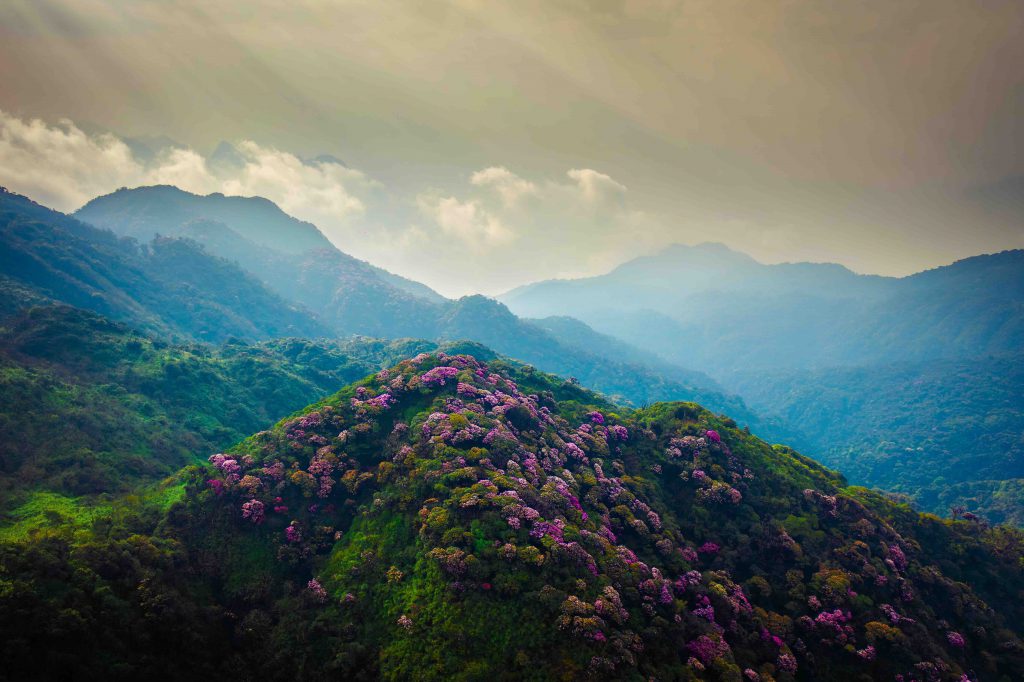Nguyen Trong Cung
Rising 3,049 meters above sea level, Putaleng is Vietnam’s third-highest peak, located in Ta Leng Commune, Lai Chau Province. In the Dao language, its original name, “Pu Ta Leng,” combines Pu meaning “mountain,” and Ta Leng, believed to be the mountain’s ancient name. Over time, “Putaleng” has become the familiar name by which travelers know this majestic summit.
There are four main routes to conquer Putaleng – from Ho Thau, Ta Leng, Giang Ma, and Si Thau Chai villages – all within Ta Leng Commune. The Si Thau Chai route is considered the steepest and most challenging, yet also the most beautiful, adorned with countless wildflowers.
I got a ride to Si Thau Chai Village. Home to ethnic Dao people, this is one of the most picturesque villages in Lai Chau, perched at an elevation of 1,500 meters. Carefully planned and beautifully maintained, the village is bisected by a cobblestone path flanked by blooming flowers of every color.
Leaving the village’s simple Dao-style houses behind, I followed my porter along a narrow dirt trail leading deep into the forest. Despite having reached many of Vietnam’s highest peaks, I was stunned by the steep ascent, so vertical that you could easily lose your hat just by looking up. Yet the crisp, oxygen-rich air made the challenge seem lighter and almost exhilarating.

Like most mountains in Vietnam, Putaleng’s vegetation shifts dramatically with altitude, from low shrubs like myrtle and hydrangea, to bamboo groves, and higher still, ancient rhododendron, chestnut, and oak trees. The Si Thau Chai route is unique in that this lush, high-altitude forest appears unusually early in the climb. Along the trail, clusters of old rhododendron trees stand tall among snowbell flowers – a rare species also known as “white resin bells.” These delicate, downward-facing white blossoms emit a sweet fragrance that lingers in the air.
Three hours of continuous climbing brought me to a small cardamom hut nestled deep in the forest – a rest station for local farmers. Around it, vibrant rhododendrons were in full bloom. At an altitude of 2,200 meters, only pink and white varieties thrive, while those of deeper hues grow higher up. The towering old trees filled me with awe, their vast canopies spread wide yet never intertwined, leaving pockets of sunlight to nourish the plants below. It felt like nature’s quiet conversation, a perfect harmony of coexistence.
Lunch finished, I resumed the trek under the blazing sun, pushing slowly through the cardamom forest and fallen blossoms that carpeted the ground. From an open ridge, I gazed across a valley awash with crimson and violet flowers glowing against the dark green mountainside. The cool breeze rising from the depths below brought with it a surge of energy that carried me onward. By 3 p.m., I reached the Si Thau Chai Camp, exhausted from the unrelenting climb. From here, the most beautiful rhododendron forest lay only a short 15-minute walk ahead. When I finally emerged into the open, the sunset bathed the landscape in golden light. The rhododendrons – mostly bright pinks and fiery reds – were strikingly vibrant, their thick petals clustered in magnificent bursts of color. Under the soft glow of dusk, the forest seemed to glow with pride, a living masterpiece painted by nature.
After a night’s rest at the camp, we began the final stretch toward the summit of Putaleng. The sensation of standing atop the peak was unforgettable – as if we were adrift on a boundless sea of clouds, gazing down at a forest of radiant rhododendrons in full bloom. Nature’s masterpiece unfolded before us, weaving emotions beyond words.
Afterward, I descended toward the Ta Leng trail, once again passing beneath the radiant rhododendrons. I strolled under the vaulted forest canopy, stepping gently over moss and fallen leaves, surrounded by blossoms that glowed overhead – a literal heaven of flowers that felt almost surreal. Unlike the flower-filled western slope, the Ta Leng side is covered in dense, damp forest and crisscrossed by streams. Along the way, ancient tea trees and mossy groves appeared like scenes from a dream, shrouded in the quiet mystery of the mountain. The vegetation is lush. This side of the mountain is home to many species, including a unique mountain frog whose tadpoles grow to remarkable size.
The return journey felt gentler, my heart brimming with the serenity of the mountains. For anyone who loves the woods, seeing Putaleng in bloom is like meeting a graceful highland maiden – rare, elusive, and unforgettable. With its song of wind and wilderness, this flower-clad mountain remains one of the most beautiful memories of my life.










